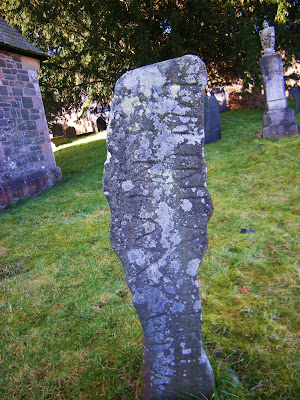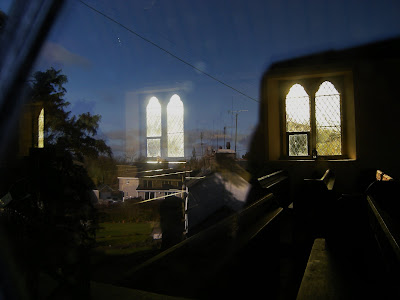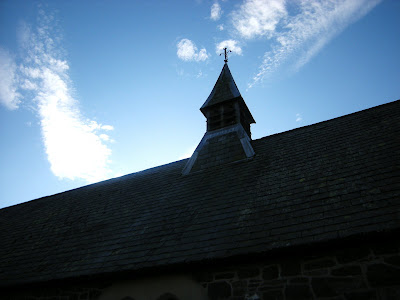











Apologies for all for the long delays in the blog, due mainly to both my computers crashing within days of each other. Hopefully normal service is now resumed.
Holywell
Two weeks ago on my weekend off, my family and I made a pilgrimage to where so many pilgrims from Monmouthshire went in the Middle Ages, to the Shrine of the Blessed St Winifred. This shrine at Holywell (The Holy Well of St Winifride) is the only shrine from Britain to come unscathed through the Reformation as the most recent building to the shrine was built by Lady Margaret, grandmother of Henry VIII.
The shrine's location is easy -off the M5-M6 at Chester and along the motorway to Chester and only a stone' s throw from Liverpool with its port and airport.
St Beuno, the local Bishop and monastic leader is said to have been the uncle of the saint.
Winifride's story-Gwenfrewi Sant in Welsh
Winifride was the daughter of two local families of standing in the Holywell area.They were as you would expect of a royal family Tewych and his wife Gwenlo. Gwenfrewi had decided to live a consecrated life as a nun but remained within her father's house until she came of age. When her parents were out of the house, a neighbouring chieftain, Caradoc came to visit, and she welcomed him as the laws of hospitality decreed. But Caradoc was overome with lust, tried to rape Gwenfrewi who managed to get away from him and ran out of the house. He set off after her and struck at her head with his sword. Where she fell, a spring of water flowed up . St Beuno came out from the church and placed her head back on her body. He led the others in prayer and she was raised to life again. A white scar was seen around her neck in witness to her martyrdom . Caradoc received the biblical punishment as the earth swallowed him up and he was never seen again.
When she was completely recovered, St Beuno made Winifred an abbess-leader of the new settlement at Gwytherin. He had discovered there a very ancient site and wished her and the holy brethren to serve God there.She died and was buried there.
Benedictines from Shrewsbury Abbey
In 1138 , Shrewsbury Abbey,a Benedicine abbey decided to come to Gwytherin and remove the bones (relics)to their own house. Most of her bones were destroyed by Protestant zealots during the time of Henry VIII and Elizabeth I but a pious person saved one finger for his own relic.This was later given back. Shrewsbury Cathedral had part of it, and the Catholic Chapel at Holywell was given the other.Both places have shrines on St Winifride's trail.
Holywell is greatly loved in Wales. It was not destroyed so many precious artifacts were hdden there, to prevent theft by various Protestant factions as abbeys and monasteries were demolished elsewhere in Britain.In particular it was a stronghold of the Jesuits supporting the recusant (secret) Catholics in penal times and many covert priests found sustenance and support there as multitudes flocked there all the way through penal times.
Celtic Holywell
In the 7th century St Beuno built the first little mud and wattle or wooden church next to the well, which would have been used for baptisms in accordance with the custom of Celtic Catholics (Universal Christians) After the Canquest, the Norman lady gave the church to St Werburgh's Abbey in Chester (1093)but by then it was probably a finer church of stone, built with alms from the many pilgrims.In the fifteenth century it was said to be falling down , and so was rebuilt by Lady Margeret of Richmond , Henry VIII grandmother.The present well chapel (now buing refurbished) was a final testament to piety and taste for pilgrimage in the Middle Ages.1115 Bradshaw wrote:
Erle Richarde intended all the dying to the best to visit Saynte Winifride , in heart desirous upon his journey went (myn autour sayeth thus) devoutly to Holywell in pilgrimage for his great merite and gostly (spiritual) advantage'.(Quoted from the Guide book by Christopher David.
The Well had a long association with Basinwek Abbey. There was a castle there originally and a House of Poor Knights Templar, whose duty it was to protect pilgrims coming to the Well. 1131AD monks from Sevigny in France had founded a Cistercian monastery at Basingwerk which remained, being on good terms with the Welsh under Owain Gwynedd. On excavating the abbey remains (also destroyed under the auspices of Henry VIII) a Saxon cell was discovered and this indicates a much earlier religious settlement from the 7th century, and some feel this may have been another foundation by St Beuno. Indeed a castle was built on the hill over Holywell in 1209 to protect the Well because the monks of Chester Abbey (now Chester Cathedral-Anglican) complained that the church at Holywell had been lost and had cost £100.The Welsh King Dafydd ap Llewelly gave the Well back to Basingwerk -closer and more Welsh friendly than the English Benedictines at Chester and nothing remains now-except the name 'Bryn y Castell'. More of the history anon.
Arrival at Holywell
We arrived on that February night, with satnav, but unfortunately many roads were being repaired and all arterial roads leading to them and so were reliant to signs saying ' Don't use satnav use this diversion!so having got lost a few times we made it to Holywell when it was very dark, but found the Convent at Ave Maria House and the Pilgrimage Centre close to the Well. We were greeted by two of the Bridgettine Nuns the portress and a 'greeter' who took us to out rooms. At £35 for B and B we thought the standard of the house was excellent. It has recently been refurbished and the rooms bright and neutral with beautiful modern shower rooms all finished to an excellent standard. The bes were comfortable and a Bible and 'History of St Bridget' in every room.
We spent a warm and comfortable night.A lift is even provided for someone like me with a damaged knee!
The Refectory was beautifully appointed, with flowers on the table and white tablecloths and we were treated to English breakfast and toast and cereal by very cheerful nuns. My husband said it did not feel right to have nuns waiting on your table, but hospitality is a charism of the Benedictines and actually in Wales as well. I can remember members of my mother's generation 'waiting' on visitors-even family, before eating themselves! Sadly it was this hospitality which led to Winifride's demise.
Gwytherin
Our first port of call was the village of Gwytherin, as it was furthest away from Holywell. We drove through wonderful hills, valleys and old Celtic earthworks to arrive here, our ears popping opposite the Lion Inn, the house opposite the Church.Now the jouney had taken but one hour and 5 mins from Holywell.(LL22822 satnav) A55,A547,A548.A544, B5382,B5384)
The Church
As we arrived, there was brilliant sunshine and a walker was doing up his shoes on the bench outside the Lion. He was walking over the top today he said, having just breakfasted he wanted to sit in the sun while he waited for his friends.This is a Welsh speaking area but there are many tourists here.
Archdeacon Thomas reported there was a ''Clas' foundation here in Celtic times and this would tie in with what we know about the Royal nature of Winifride's/Gwenfrewi's
family. Only Royal families could endow clas foundations.However the earliest dedicatee was St Eleri, an even earlier Welsh saint but when the Normans rebuilt the church on the same site, they dedicated it to St James.IT was some time before they came to grips with the Welsh culture,finding the language impossible. There is a knoll to the south of the Church which was dedicated to St Winifride (called the Penbryn Chapel) and recent research suggested the earliest 'llan' here included this chapel. I guess it might have been the original 'Capel y bedd' or grave chapel of the Virgin. This is still to be observed in North Wales, how many graves in Christian Churchyards resemble cromlechs, though dedicated to God and carrying the bones of the departed saint.
It appeared in the Pope's Taxatio in 1254 (Ecclesia de Gwytherin et Nanclyn)The Chapel had its own enclosure for a while (probably as the site had become a place of pilgrimage) There is a report from 1852 (Glynne) that the church was a simple one 'with a roof of the usual Welsh Construction'. There was some stained glass and a later report of 1858 says there were two wooden chests, of one which was a portion of the coffin of St Winifride, an octagonal font. There are also four ancient yews in the churchyard (still there today) . There is a round headed priest's door which had been blocked and a dormer window to light the gallery. By the 1860's it was run down and rebuilt according to its original specifications in 1867-9.Two mediaeval grave stones were uncovered at this time.
In 1990 the church was rededicated after de-consecration in 1982 and 8 years of disuse.Archesologists came with geophysics to find the chapel site in the field to the South of the Church. This is certainly where legend has it. In the recent ITV Cadfael series in the episode 'A Morbid Taste for Bones'it is certainly the location and the uncovering of the grave site is reenacted. This episode is now on DVD. The geophysics team could not find it.In 1729 the site was incorporated withing the Gwytherin Churchyard again, and it is possible that being a 'Chapel' area, Protestants had removed every trace of the 'Capel y Bedd'during the time of the dictator Cromwell.The ground drops to a natural hollow before rising to the site of the Penbryn Chapel.
Now there is a neat church, with excellently kept graveyard. It has a neve and chancel in one chamber a south porch and a north vestry. There is a small bell turret centrally set over the nave in line with the porch and it faces East as you would expect-towards Jerusalem.
The Church Interior
We were not allowed inside the church for reasons I shall explain in a minute.But from a description, the walls are whitewashed . The floor of the nave is tiled. Interestingly there are two steps up to the sanctuary (no Chancel) which has a grave slab and another in the north wall, possibly the original site of the Easter Sepulchre.(Place where the Crucifix and veils etc for Maundy Thursday, Good Friday and Easter Vigil were kept)These were also desecrated and destroyed by Elizabeth's officers.
Churchyard Items
In keeping with the site of the Church and Chapel being on an earlier site-possibly Druid place of meeting or 'initiation', there are four aligned stones, standing next to each other. One you can still read as a Latin incription 'Vinnemaglus , son of Senemaglus over an even older Ogham (celtic tree alphabet incription).(These are dated to the 5th or early 6th centuries)These are less than three metres apart.
There are four ancient yew trees.
Gwytherin lies in a valley that serves as the confluence of the River Afon Cledwen with the many streams that flow down from the hillsides.
Gwytherin Church-The Plight of the Gwytherin Christians in 2009
In the churchyard I met Sue who still acts as a church warden to the church. She told me, although the church had a loyal congregation of 8 (regular worshippers) more at Christmas and Easter that the Church in Wales had closed it down to be sold! I was very surprised as it had only just been rededicated and repaired with I guess lottery money. She told me that the Welsh Chapel on the hill had closed down through lack of members and the church had actually been sold to two local men who wanted to open it up again for worship for the community once a month. She said all eight had stopped going to Church and the brothers had been refused planning permission by Conway Council (??) I think they were hoping it would be sold to a private buyer, but no explanation was given. I think this is ridiculous. The village is overrun with tourists in the summer and pilgrims, doing the Winifred Trail.Moreover the locals are convinced that some of the remains of St Winifred remained there.I also was sorry I could not go in-as I do to say the rosary in all these pilgrimage sites, and had to content myself with sitting on a cromlech (I know-but no bench) and saying the Glorious mysteries for a women who reputedly spent 30 years of her life in this place in the service of God.You can hear my conversation with Sue on the podcast I am releasing in the next few days.
Let us hope that the intercession of Gwenfrewi/Winifride for the people of her settlement will have a good outcome, as they have appealed the decision by the council. Everyone should visit this special village.
My next post will concern where we went that afternoon-the Cathedral Church of St Asaph (now Anglican)founded by St Kentigern in AD 560!






















































































No comments:
Post a Comment